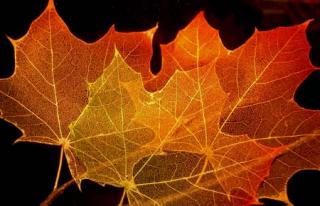Amik Ahmad
Sheiva Rezvani
Nature's Footprint
A digital installation that lets you play with leaves in the wind.
http://www.sheiva.com/natures_footprint.html

Classes
Introduction to Computational Media,Introduction to Physical Computing
Introduction to Computational Media,Introduction to Physical Computing
Imagine looking down at your feet and, suddenly, leaves begin to swirl and move around you as if you were outside. Nature's Footprint utilizes an interactive animation to react to the movement of people walking into a space so that they can play with a digital gust of wind that blows leaves out of their path.
Background
The idea for our sketch began with a simple inspiration: how your sensory experience is changed when leaves are surprisingly blown into your path. In order to better understand the different required physics environments possible for our animated projection, we met with multiple instructors and residents at ITP. We also did some testing for the best possible user experience. While we were building we looked at quite a few examples of other sketches and physics environments that utilized similar movements and interactions.
Audience
Anyone who loves to play with leaves in the wind! This includes people of all ages!
User Scenario
Our users will see an animation of leaves projected on the floor which will entice them to come interact with the space. Once the user has entered the space, they will see that their presence alters the motion of the leaves. From there it is up to them to play with the leaves as they wish!
Implementation
Our project combines a projector a few feet away from a kinect both pointing directly down into the space where our animation is being projected on the floor. There is also a computer that these components are hooked up to that runs our code in Processing.<br /><br /><br /><br /><br /><br /> The Processing sketch is utilizing the openkinect library and passing an infrared (IR) and depth image into opencv which is running blob detection. From there we built an environment with animated leaves that are blowing in one direction and interact with each detected "blob" or person by pushing the leaves away.
Conclusion
We encountered many challenges while making this project, but ultimately are proud of what we were able to accomplish. We learned that different coding libraries, pieces of equipment and operating systems don't always get along. We learned that at ITP there is always someone to help you through the hard days. We learned that hard days are almost always followed by major breakthroughs that make everything worthwhile. And last but not least: we learned that the uphill battle with new & unexpected technologies is worth the climb and nothing to be scared of!
Background
The idea for our sketch began with a simple inspiration: how your sensory experience is changed when leaves are surprisingly blown into your path. In order to better understand the different required physics environments possible for our animated projection, we met with multiple instructors and residents at ITP. We also did some testing for the best possible user experience. While we were building we looked at quite a few examples of other sketches and physics environments that utilized similar movements and interactions.
Audience
Anyone who loves to play with leaves in the wind! This includes people of all ages!
User Scenario
Our users will see an animation of leaves projected on the floor which will entice them to come interact with the space. Once the user has entered the space, they will see that their presence alters the motion of the leaves. From there it is up to them to play with the leaves as they wish!
Implementation
Our project combines a projector a few feet away from a kinect both pointing directly down into the space where our animation is being projected on the floor. There is also a computer that these components are hooked up to that runs our code in Processing.<br /><br /><br /><br /><br /><br /> The Processing sketch is utilizing the openkinect library and passing an infrared (IR) and depth image into opencv which is running blob detection. From there we built an environment with animated leaves that are blowing in one direction and interact with each detected "blob" or person by pushing the leaves away.
Conclusion
We encountered many challenges while making this project, but ultimately are proud of what we were able to accomplish. We learned that different coding libraries, pieces of equipment and operating systems don't always get along. We learned that at ITP there is always someone to help you through the hard days. We learned that hard days are almost always followed by major breakthroughs that make everything worthwhile. And last but not least: we learned that the uphill battle with new & unexpected technologies is worth the climb and nothing to be scared of!

